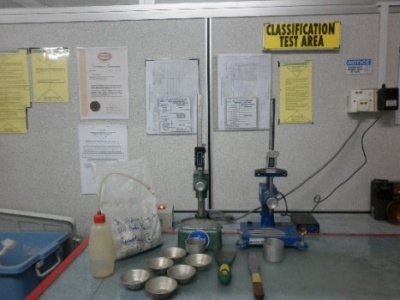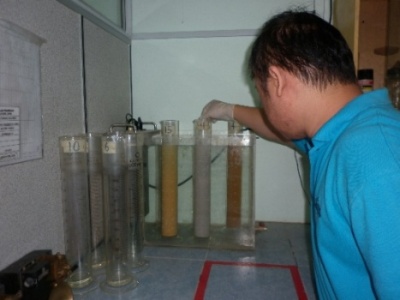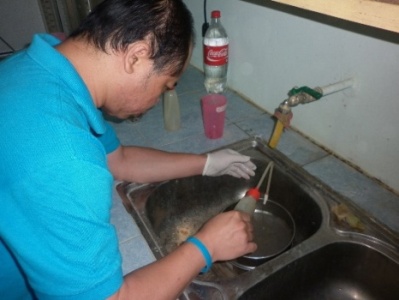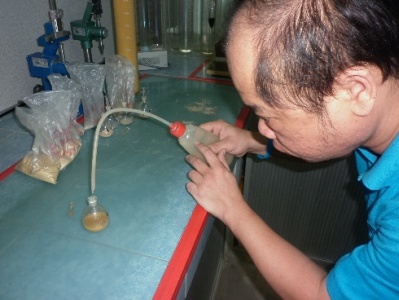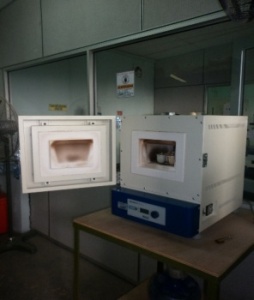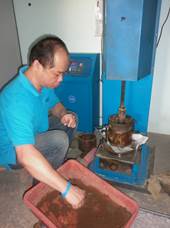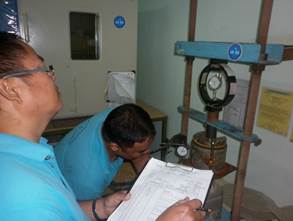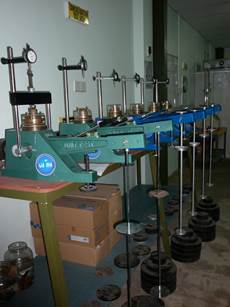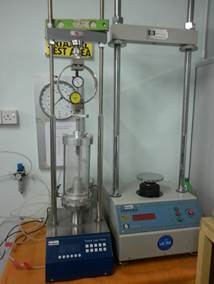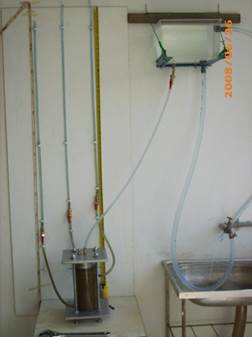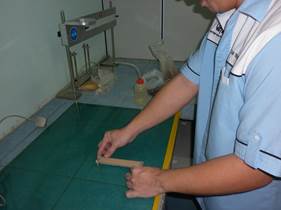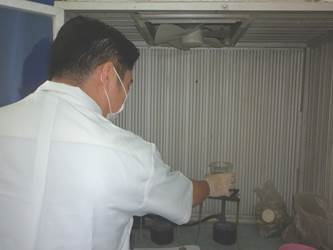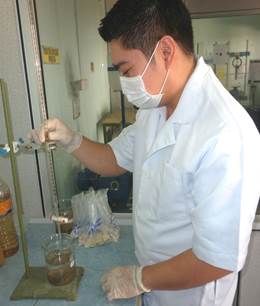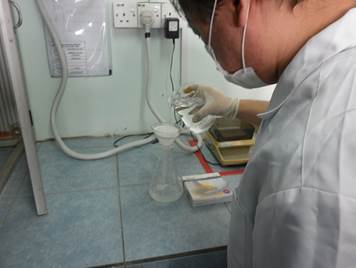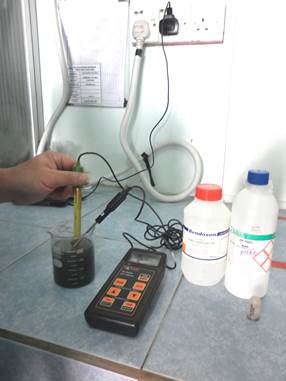Soil, Foundation, Geotechnical and Geological Specialist.......
|
|
|
|
Soil Laboratory Testing (Compliance to BS 1377:1990)
a) Moisture Content
b) Atterberg Limit (Casagrande Method) c) Atterberg Limit (Cone Penetrometer Method) d) Hydrometer (Wet Sieving) e) Particle Size Distribution f) Emerson Crumb Test g) Specific Gravity h) Loss on Ignition i) Compaction Test j) California Bearing Ratio k) One Dimensional Consolidation Test l) Constant Head Permeability Test m) Falling Head Permeability Test n) Linear Shrinkage Test o) Total Sulphate Content p) Chloride Content Test q) Organic Matter Content r) pH Value Test
(a) MOISTURE CONTENT
To determine the amount of water present in a soil expressed as a percentage of the mass of dry soil.
This is termed the moisture content of the soil.
(b) ATTERBERG LIMIT
Atterberg limit and defined as the water content corresponding to different behavior conditions of silts and clays.
Atterberg limit consists of 3 component testing, such as liquid limit, plastic limit and plasticity index.
(c) CONE PENETROMETER METHOD (DEFINITIVE METHOD)
Cone penetrometer consists of a metal cup, approximately 55 mm in diameter & 40 mm deep, is filled with the paste and
the surface struck off level. The cone, of mass 80g, is next placed at the centre of the smoothed soil surface & level with it. The cone is released so that it penetrates into the soil and the amount of penetration over a time period of 5 seconds is measured.
(d) HYDROMETER (WET SIEVING)
The hydrometer test is used to fine the size of smaller grains. It is a sedimentation test, the rate at which particles
settle is used as an indication of their size. The hydrometer test is based on a stoke law, which relates the diameter
of a single sphere to the time required for the sphere to fall a certain distance in a liquid of known viscosity.
(e) PARTICLE SIZE DISTRIBUTION
The particle size distribution of a soil is carried out by determining the weight percentages falling within bands of size represented by these divisions and sub-divisions. In the case of a coarse soil from which fine-grained particles
have been removed or were absent, the usual process is a sieve analysis.
(f) EMERSON CRUMB TEST
Crumb test is a method used to identify dispersive of clay soils by observing the behavior of a few crumbs of soils which is placed in a dilute solution of sodium hydroxide.
(g) SPECIFIC GRAVITY (SG)
The specific gravity is a dimensionless parameter that relates the density of soil particle to the density of water.
The SG of soil solids is determined by using a 50 ml or 100 ml density bottle or a 500 ml pyknometer.
(h) LOSS ON IGNITION
The Loss on Ignition Test is designed to measure the amount of moisture or impurities lost when the sample is ignited under the conditions specified in the individual monograph.
(i) COMPACTION TEST (maximum dry density VS water content relationship)
(j) CALIFORNIA BEARING RATIO
California Bearing Ratios Tests is a penetration test developed by California state highway department (USA)
for evaluating the bearing capacity of sub-grade soil for design of flexible pavement. The test is carried out on
natural or compacted soils in water soaked or un-soaked conditions and the results obtained are compared with the
curves of standard test to have an idea of the soil strength of the sub-grade soil.
(k) ONE DIMENSIONAL CONSOLIDATION TEST
This test is used to determine the consolidation characteristics of soils of low permeability. It is carried out on specimens
prepared from undisturbed samples. Data obtained from these tests together with classification data and knowledge of soils loading history, enable estimates to be made of the behavior of foundations under load.
(l) TRIAXIAL COMPRESSION TEST (UU)
The objective of the unconfined compression test is to determine the UU (unconsolidated, undrained) strength of a cohesive soil in an inexpensive manner. Shear characteristics of the soil are obtained by the undrained triaxial test. In this test, 38 mm diameter or 100 mm diameter samples were tested in compression under a series of varied lateral pressures, and the angle of shearing resistance and apparent cohesion obtained.
(m) CONSTANT HEAD PERMEABILITY TEST
Constant head is used for testing the permeability of granular soils (sands & gravels). The specimen is formed in
a permeability cell and water is passed through it from a constant level tank. Take-off points located along the sides of the permeability cell are connected to three manometer tubes mounted on a panel completer with a metre scale. Water passing through the specimen is collected and measured, either for a specific quantity or over a period of time.
(n) FALLING HEAD PERMEABILITY TEST
Clays and silts are tested using the falling head technique. Flow of water through the specimen is observed by monitoring the rate of fall of water in the tube. It is essential that soils of very low permeability are sealed inside the cylinder to prevent seepage along the sides of the specimen. Before testing the specimen must be completely saturated with water as the presence of air will restrict the flow of water.
(o) LINEAR SHRINKAGE TEST
For soil with very small clay content the liquid & plastic limit may not produce reliable results. An approximation of the plasticity index may be obtained in such cases by measuring the linear shrinkage.
(p) TOTAL SULPHATE CONTENT TEST
The total sulphate content of aggregate is usually measured to assess whether the aggregate's contribution to the total sulphate content of a concrete mix will be low enough to prevent any deleterious effects.
(q) CHLORIDE CONTENT TEST
The total chloride content of aggregate is usually measured to assess whether the aggregate's
contribution to the total chloride content of a concrete mix will be low enough to prevent the early
onset of corrosion of any embedded steel reinforcement. The test can be conducted in a variety
of chemical means, from approximate dip-stick measures through to potentiometric methods.
The usual method is by titration.
(q) ORGANIC MATTER CONTENT TEST
Organic matter is stable in the soil. It has been decomposed until it is resistant to further decomposition. Usually, only about 5 percent of it mineralizes yearly. that rate increases if temperature, oxygen, and moisture conditions become favorable for decomposition, which often occurs with excessive tillage. It is the stable organic matter that is analyzed in the soil test.
(r) PH VALUE TEST
The pH value test is carry out by the electrometric method, which gives a direct reading of the pH value
of a soil suspension in water. Determination of pH is a common test carried out at laboratories and is a
measurement of the amount of hydronium ions (H3O+) or protein (H+). The pH scale is based on values
between 0 and 14, with 7 being neutral. pH values above 7 are considered to be basic or alkaline while less
than 7 would be considered acidic. This method can also be used for determining the pH value of a sample of
ground water.
|



